
Dan Feidt's log on Minnesota, Information Operations, spinstorms and latent contradictions.
Currently I am putting together a sweet Google Earth view of the south Lebanon tactical situation. In these images, various map overlays have been turned on and off. The first image shows bookmarks and tactical IDF troop maps from Stratfor. These locations are estimated and perhaps tainted with disinformation, but still probably roughly right.
The major overlay map is farther below. I lined all these up by eye, and made use of the transparency of PNG files to make nice translucent edges on the images. Israeli flags mark Lebanese villages (theoretically) occupied by Israeli forces. The blue boxes are notable Israeli units - their types are noted in the big image, which you can go get yourself from the Agonist's fine coverage.
You can download the complete Google Earth animation I put together so far at this link. It should drop right into your Google Earth Browser. Just run the folder as an animation (press play), and toggle the image overlays on and off for various views of the military situation.
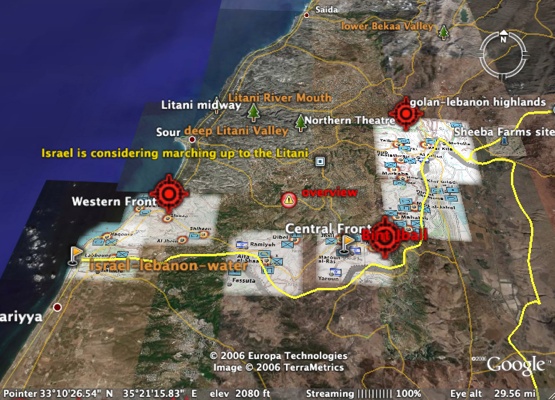
This is in the close quarters around the Kiryat Shmona (Qiryat Shmona), an Israeli city that has been heavily pounded with dozens of rockets every day.
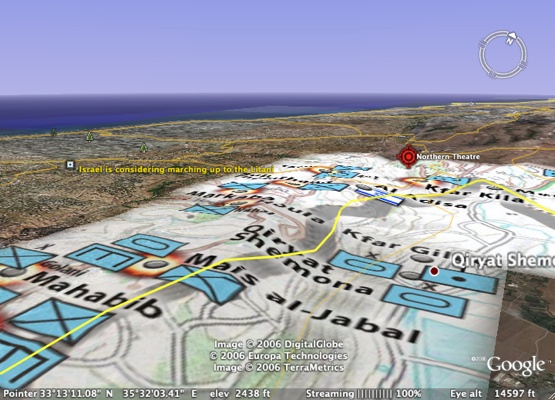
Here is (almost) the same view, just satellite, without tactical overlay:
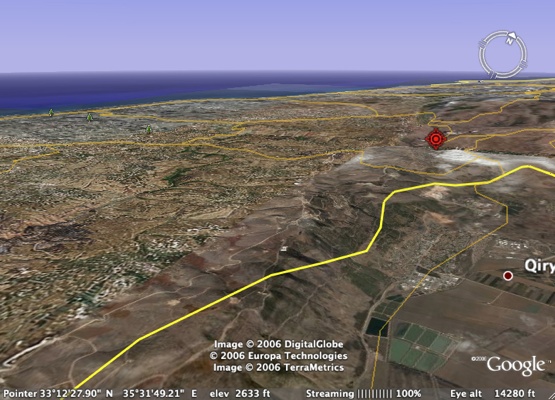
This shot faces back south. The white line here indicates the line to the Israeli border, about 11 miles. This is the upper part of the Litani River valley, a very deep feature running from the Bekaa Valley to the Mediterranean, well north of Tyre. The Israelis occupied up to the Litani River until they were defeated by Hezbollah and withdrew sans peace agreement in 2000.
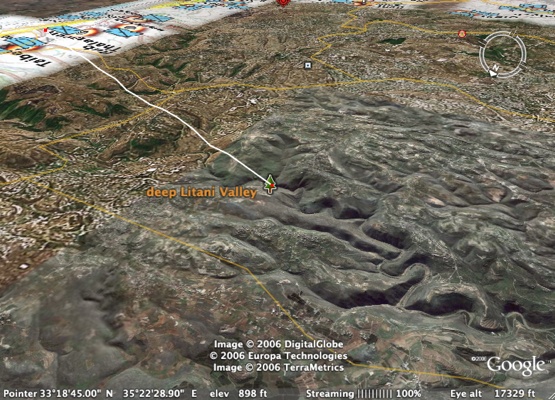
If we zoom back a bit farther, this image adds the original large Stratfor map, placed on top of the landscape - higher altitude, same angle. THe whole area up and to the right is where the Israelis would try to conquer and destroy Hezbollah. However, as we can see, Israel has had little luck getting securing the immediate few thousand meters of the Lebanese south border region - the line of explosions along the top here: (we are facing south-southeast)
If we flip it around, facing north from above northern Israel, look here. This is the big Stratfor master map, not the detailed tactical views noted above.
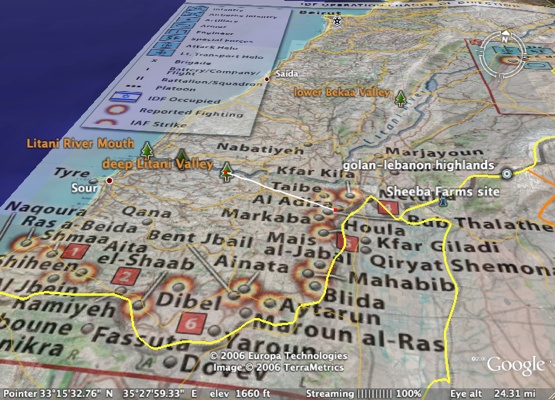
Well that is all for now. Oh wait no it isn't. From the bowels of eccentric retired Israeli hawks come a couple stories from DEBKAFile – a weird news source to be taken with grains of salt. Still, there is much of interest from Debka:
DEBKAfile’s military sources disclose: Hizballah’s rocket offensive against Israel is orchestrated from a rear command located in the Syrian town of Anjar
August 7, 2006, 12:41 PM (GMT+02:00)
While Israeli officials keep on insisting that Syria must be kept out of the conflict, the fact is that the Assad regime is already in it up to their ears – with a leading role in the Hizballah rocket attacks on northern Israel.
The command which coordinates the pace of those attacks is located at the Anjar base of the Syrian Army’s 10th Division opposite the Lebanese town of Az Zabdani. It is manned by Iranian and Hizballah officers, who take their orders from a Syrian military intelligence center in Damascus to which Iranian Revolutionary Guards intelligence officers are attached. It is headed by a general from one of Syria’s surface missile brigades. This joint command is provided with the most up-to-date intelligence and electronic data available to Syria on targets in Israel and IDF movements. The timing and tempo of Hizballah rocket strikes are set according to that information.
To keep the rockets coming without interruption, the joint Hizballah-Syrian-Iranian command is also responsible with keeping Hizballah supplied with an inflow of rockets and launchers. They use smuggling rings to slip the supplies into Lebanon by mule and donkey which ply the 5,000-7,000 feet mountain paths that straddle the Syrian-Lebanese frontier.
A senior Israeli officer told DEBKAfile: We can go on bombing Lebanon for many weeks, but that will not stop the rockets..
 Meanwhile Zarqawi-Mark-2 has arrived to save the day. This story smacks of some truth and a lot of hot air. But still interesting:
Meanwhile Zarqawi-Mark-2 has arrived to save the day. This story smacks of some truth and a lot of hot air. But still interesting:
Tehran Sends Archterrorist Mughniyeh to Rescue Hizballah
DEBKAfile’s Exclusive Military Report: August 5, 2006, 4:57 PM (GMT+02:00)
In the middle of the fourth week of the Lebanon War, the tide began to turn in Israel’s favor. DEBKAfile’s military sources report the battlefield finally responded to the effect of Israel’s air might, its tank columns, the pounding by mobile artillery and naval craft and its repeated armored infantry assaults.
After losing 44 fighting men, more than 30 civilians, many thousands of wounded and billions of dollars of damage, finally, the Israeli military was given the chance to do what it does best: focus its firepower instead of spreading it out thin over too many targets.
The setbacks of the first three weeks were partly due to tactical incompetence and laggard decision-making on the part of prime minister Ehud Olmert and defense minister Peretz. Israeli troops therefore spent too long in abrading combat against stubborn Hizballah resistance in such places as Maroun er Ras and Bint Jubeil. But as soon as Israeli ground forces shifted to the massive, long-distance firing mode which they knows best, the impact on the warfront was immediate. The battle went their way with a minimum of casualties. In places where Israeli troops adhered to the close combat tactics practiced in the first three weeks, they continued to suffer high casualties.
Hizballah soon showed signs of distress. Lacking the weapons and resources to stand up to IDF’s precise-shooting juggernaut, their commanders quickly pulled their men out most combat sectors of South Lebanon and ordered them to regroup in five places:
1. The Western Sector and the center of Tyre.
2. The Wadi Hajar pocket east of Tyre.
3. The Central Sector surrounding Bint Jubeil, where the outcome is still unresolved after many days of fighting.
4. The Wadi Saluki area northwest of the northernmost Israeli town of Metullah.
5. The Eastern Sector, including al Khiam, the Shabaa Farms and Mt Dov, which has seen little fighting - although last week Israeli forces began - then stopped - a major offensive before it got underway.
These pockets are now the main launching-pads for rockets fired into Israel. Outside, there is no ground fighting in South Lebanon but for Israeli air strikes.
Hizballah also has also been using the Tapuach and al-Haroub areas south and northeast of Sidon for shooting rockets. It is from this region that Hizballah fired the long-range Khaibar-1 missiles at Hadera Friday night, August 4, which came 45 km short of Tel Aviv. Saturday morning, Sidon’s 200,000 inhabitants and its outlying villages up to the Zahrani River were warned to leave their homes and head north to escape the coming Israeli air offensive.
Until the Khaibar attack on Hadera, the concentration of Hizballah’s rocket launchers and stores in and around Sidon had been immune from Israeli attack – largely because Olmert and his senior ministers refused to increase the number of ground troops deployed in Lebanon. The military commanders had to do their best with the limited numbers available.
In other words, with the right manpower level, Hizballah’s abilty to fire rockets can be dented, notwithstanding claims by Israel officials and generals that there is no way to do this when most of Hizballah’s 13,000-rocket stockpile remains intact.
But even cutting down on the daily 200-plus rocket blitz on northern Israel is not plain sailing because:
First, Neither the Israeli Air Force nor any other air force is capable of completely halting rocket fire from the ground. In the relatively small distances between Lebanon and Israel, the short-range Katyusha rockets have the effect of medium-range weapons, while the short-to-medium range rockets perform like long-range missiles.
Second, Israel does not have enough infantry on the ground to make substantial inroads on Hizballah’s rocket-firing capabilities.
Third, Iran and Syria are constantly restocking Hizballah’s diminishing supplies of rockets of all types, launchers and operating manpower by a round- the-clock airlift from Iran via Syrian military air fields. Some of the incoming supplies are destroyed by Israeli air attacks as they cross into Lebanon, but a substantial part is conveyed to Hizballah by smuggling networks employing mules to traverse Lebanese mountain paths. Even if 2,000 have been wiped out and a similar amount has been fired, no one knows how many are left in stock because it is replenished. As long as that corridor is not severed by bombing the Syrian stopover air facilities, Iran will continue to top up Hizballah’s stockpile. Therefore, the rocket offensive cannot be reduced by very much.
Fourth, Israeli forces do not operate in all parts of South Lebanon.
Hizballah’s withdrawal to five pockets in South Lebanon affords the IDF certain tactical advantages - although liabilities too.
The Advantages:
It is now possible to carve the region the Israeli army controls into three sections, western, central and eastern, a tactic familiar from the Gaza Strip, for encumbering Hizballah guerrilla movement between the sections. The goal is to confine Hizballah to the five pockets and place them under blockade. They can then be made to capitulate or face liquidation.
The Liabilities:
Leaving the two banks of the Litani River, the Nabatea plain and Hazbaya to the north of the river in Hizballah hands leaves a route open for its reinforcements to come through and to strike Israeli forces from the rear.
Nonetheless, by Thursday, August 3, Hizballah was showing signs of being in trouble.
A. Local Hizballah village commanders signaled repeated appeals for more manpower and ammunition. The appeals were not met because outside forces cannot break through the defense lines held by the advancing Israeli troops. The village commanders were therefore told by their superiors to fight to the last man and last bullet and reserve the last grenade for suicide.
B. Hizballah’s shadowy leader, the long-wanted Imad Mughniyeh, was hurriedly appointed commander of the southern front as a last resort to save South Lebanon from falling to Israel.(picture from the 1980s)
DEBKAfile’s military and counter-terror sources maintain that this appointment raises the conflict to a new and dangerous level on several counts.
Mughniyeh, wanted for a quarter of a century by the FBI for the huge bombing attacks he orchestrated on the US embassy in Beirut and American and French troops, as well as a spate of hijackings and murders, is important enough to take orders from no-one ranking lower than Iran’s supreme ruler, Ayatollah Ali Khamenei. Those orders come through the Revolutionary Guards commander Gen. Rahim Safavi.
Therefore, placing Mughniyeh at the head of Hizballah forces in South Lebanon confronts prime minister Olmert uncomfortably close to Iran’s supreme leader; ranges defense minister Peretz opposite his Iranian counterpart Mustafa Najer and chief of staff Lt. Gen Dan Halutz opposite Gen. Safavi, while on the warfront, Israel’s war leaders face the formidable Mughniyeh, Tehran’s secret weapon for rescuing Hizballah from collapse.
Informed circles in the West have a high opinion of Mughniyeh’s military, intelligence and tactical skills. His hand was seen in the transformation of al Qaeda’s 2001 defeat in Afghanistan into a launch pad for its anti-US campaign in Iraq and many other ventures in the terror war against America. After the death of Abu Musab al Zarqawi, Mughniyeh is rated the world Islamic terror movement’s most outstanding field commander.
Therefore, while the appointment is a measure of Israel’s belated military success in the Lebanese war, it also brings the conflict ever closer to two dangerous orbits – Tehran and al Qaeda. Mughniyeh is the only undercover agent in the Middle East who enjoys the complete personal trust of Khamenei and Osama bin Laden, on both of whom he is in a position to call for aid.
On the diplomatic front, even if the United States and France can get together on a unified UN Security Council ceasefire resolution, DEBKAfile’s military sources report that neither Iran nor Hizballah has any intention of complying with a resolution dictated by the United States, France and Israel.
Well at the very least, that last bit is exactly the message a bunch of neo-Likudniks would want to be saying, regardless of whether or not it's true. But it might be true. I think these guys are far too optimistic about Israel's situation.
Anyhow that's pretty much the lay of the land, so to speak.
Posted by HongPong at August 9, 2006 01:45 AM